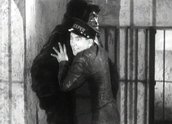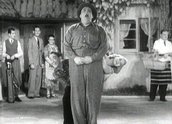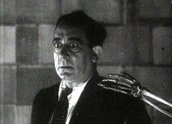


Gone to the Dogs (1939)
Synopsis
While working as a zookeeper, George (George Wallace) accidentally invents a tonic that makes dogs run faster. He and his mate Henry (John Dobbie) are sacked for impersonating a gorilla, so they try the tonic on their landlady’s greyhound Black Beauty, an aspiring champion. It works, but George can’t remember what’s in it, so his friend Jimmy (John Fleeting), a veterinarian, has to work it out.
With a major race approaching, arch villain Gustav Sunderman (Lou Vernon) and his henchmen plan to steal Black Beauty and put another black dog in his place. George witnesses the substitution, so he and Henry and their dog Aloysius follow the gang to their hideout, in a house that’s reputed to be haunted. After many scrapes and scares, they escape, pursued by henchmen. They commandeer a plane to fly them to the dog track, where they unmask the substitution. The real Black Beauty romps home and George and Henry are heroes.
Curator’s notes
Gone to the Dogs is the second of two comedies that George Wallace made with Cinesound, after Let George Do It (1938). It’s a more ambitious production, although the results are patchy. Wallace was an accomplished singer and songwriter, as well as a dancer and comedian, so this film offers a major musical song and dance interlude (clip two) that features dogs, children, dancing girls and backing singers on bicycles! The humour is more slapstick, the plot more perfunctory and far-fetched.
Ken Hall was in the habit of building a story from back to front. He often came up with a finale first, then built a plot to get to it. In this one it’s a dog race, a subject that was relatively novel, because greyhound racing had only become regulated in New South Wales in 1932. Going to 'the dogs’ was a popular pastime, even a craze, by the late 1930s – hence the words in George Wallace’s song in clip two. There’s a strong resemblance between this finale and that of a film made in 1927, The Kid Stakes. That film features a children’s goat race, but the kids get to the track in the same manner as George and Henry – they commandeer an aeroplane. There is no question that Hall would have known of the earlier film, but so would many members of the audience. Hall tended to borrow freely from films he liked, although rarely was it as obvious.
The robbers’ hide-out in a haunted house is a direct 'borrow’ from Buster Keaton’s 1921 short comedy The Haunted House. The big musical production number is certainly heavily derived from the style of Hollywood musicals of the 1930s, albeit with fewer resources. Lois Green, the blonde actress who whips off her skirt, was a star of musical comedy for JC Williamson’s theatrical company. This appears to have been her only film.
- Overview
- Curator’s notes
- Video 3 clips
- Principal credits
- Find a copy
- Comments 1
- Map
- Add your review



